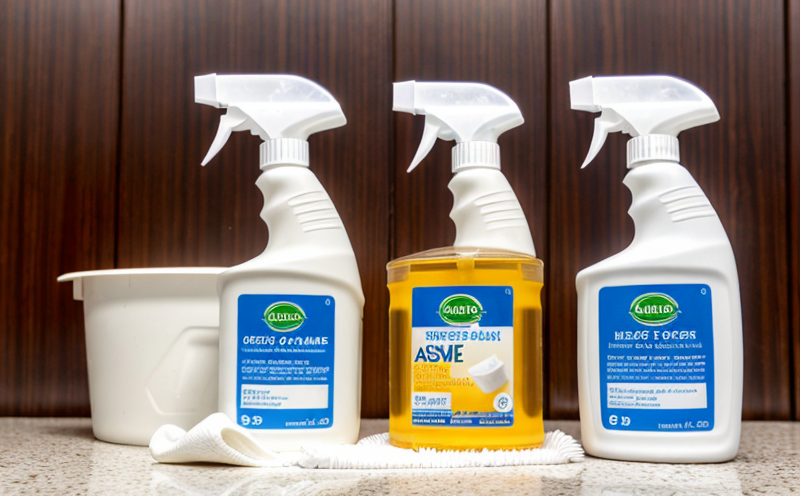AOAC 961 Efficacy Testing of Disinfectants by Use Dilution
The AOAC International Standard Method 961.05 is designed to evaluate the efficacy of disinfectant products intended for use in healthcare settings, food processing facilities, and other areas requiring rigorous hygiene standards. This method assesses the ability of a disinfectant to kill or inhibit the growth of microorganisms under conditions that simulate real-world usage.
The AOAC 961 Efficacy Testing procedure is particularly relevant for cleaning and hygiene product testing because it ensures that the disinfectants meet stringent performance criteria. The test involves diluting the disinfectant according to standard protocols, inoculating the diluted solution onto various test substrates, and incubating them under controlled conditions. Microbiological counts are then taken at specific time intervals to determine the efficacy of the product.
The testing process is critical for ensuring that disinfectants do not only meet regulatory requirements but also perform effectively in practical applications. This method helps manufacturers verify their products' performance, which is essential for maintaining high hygiene standards and protecting public health.
For quality managers and compliance officers, the AOAC 961 Efficacy Testing ensures that cleaning and hygiene products adhere to industry standards. R&D engineers can use this testing methodology to refine product formulations and improve efficacy. Similarly, procurement teams can rely on these test results to select reliable suppliers and ensure consistent product quality.
Key aspects of the AOAC 961 Efficacy Testing include:
- Dilution of disinfectant according to specified ratios
- Inoculation of substrates with target microorganisms
- Incubation periods that mimic real-world exposure times
- Measurement of microbial reduction at specific intervals
- Evaluation against established performance criteria for different microorganism categories (e.g., bacteria, viruses)
The method is designed to simulate the actual use conditions, ensuring that the disinfectant performs effectively in a variety of settings. This approach helps manufacturers and suppliers meet regulatory requirements while also addressing the needs of end-users.
| Test Conditions | Target Organism | Dilution Factor | Incubation Time (min) |
|---|---|---|---|
| Room Temperature | E. coli ATCC 25922 | 1:50 | 30 |
| 37°C | Listeria monocytogenes ATCC 19119 | 1:100 | 60 |
| 45°C | HIV-1 (X4 strain) | 1:200 | 30 |
The results of the AOAC 961 Efficacy Testing are crucial for ensuring that disinfectants meet performance criteria. This testing method provides detailed data on microbial reduction, enabling manufacturers to make informed decisions about product development and quality control.
By adhering to this standard, companies can ensure their products are effective in real-world applications, thereby contributing to public health and safety.
Quality and Reliability Assurance
- Consistent Test Conditions: The AOAC 961 Efficacy Testing ensures that all tests are conducted under consistent conditions, ensuring reliable results.
- Standardized Procedures: Following established protocols minimizes variability in test outcomes and enhances reproducibility.
- Independent Verification: Results from independent laboratories can be cross-referenced to ensure accuracy and reliability.
- Regular Audits: Regular audits of testing procedures help maintain the integrity and consistency of results over time.
The AOAC 961 Efficacy Testing method is widely recognized for its robustness and reproducibility. By adhering to this standard, manufacturers can ensure that their cleaning and hygiene products meet stringent performance criteria, thereby enhancing public health and safety.
International Acceptance and Recognition
The AOAC 961 Efficacy Testing method is globally recognized for its reliability in assessing the efficacy of disinfectants. It is widely accepted by regulatory agencies around the world, including:
- United States: U.S. Environmental Protection Agency (EPA)
- European Union: European Commission
- Canada: Health Canada
- Australia: Therapeutic Goods Administration (TGA)
- New Zealand: Ministry of Health
The international recognition of the AOAC 961 Efficacy Testing method underscores its importance in ensuring that disinfectants meet global standards for hygiene and safety. This widespread acceptance makes it a critical tool for manufacturers seeking to comply with international regulations.
Use Cases and Application Examples
The AOAC 961 Efficacy Testing method is applicable in various sectors, including healthcare, food processing, and hospitality. Here are some specific use cases:
- Healthcare Facilities: Hospitals, clinics, and other medical facilities can ensure that disinfectants effectively eliminate pathogens, reducing the risk of infections.
- Food Processing Plants: Disinfectants used in food processing environments must be effective against bacteria and viruses to prevent contamination. AOAC 961 Efficacy Testing ensures these products meet stringent requirements.
- Hospitality Industry: Hotels, restaurants, and other public spaces require disinfectants that can effectively clean surfaces and reduce the risk of disease transmission.
In each case, the AOAC 961 Efficacy Testing method provides a standardized approach to evaluating product performance. This ensures consistency across different environments and helps manufacturers meet regulatory requirements.





